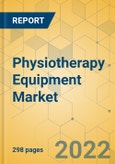Speak directly to the analyst to clarify any post sales queries you may have.
The global physiotherapy equipment market is expected to grow at a CAGR of 6.84% during 2022-2027
Benefits of Physiotherapy
- Provides valuable information on maintenance and support programs to minimize the re-occurrence of a certain condition or functional decline
- Boosts and maintains physical performance and overall body function
- Assists with injury, disability, and disease processes
- Restores injury and the effects of disability with selected exercise programs and other necessary activities
- Controls acute and chronic conditions and activity restrictions
SEGMENTS ANALYSIS
The ultrasound therapy equipment market accounted for the highest revenue share of around 22%, followed by the electrotherapy equipment segment. However, the combination therapy equipment segment is expected to grow at a high single-digit CAGR during the forecast period as combination physical therapies are clinically proven and have better safety and efficacy rates. As a result, physiotherapists highly recommend combination physical therapies for patients and procure a wide range of advanced and innovative combination physiotherapy equipment.
The cardiorespiratory application segment reported a major share of around 32%, and the neurological application segment accounted for the least share in 2021. The cardiorespiratory segment is estimated to be the most profitable segment, and it is expected to retain its dominant position during the forecast period. An increase in the prevalence of cardiorespiratory disorders due to the rising geriatric population and lifestyle diseases are primary drivers of the segment
During the forecast period, the musculoskeletal application segment is likely to grow faster than other segments. Common musculoskeletal disorders, such as lower back pain, are the most widespread reasons for patients visiting physiotherapists, which is expected to drive the market growth. Although lockdowns worldwide have influenced the physiotherapy profession, the market has bounced back quickly from the lows of H2 2020 & H1 2021. In addition, the market witnessed a new trend of virtual physiotherapy and rehabilitation during lockdowns and closure of physiotherapy clinics and hospitals during the 1st wave and 2nd waves of the covid-19 pandemic.
Segmentation by Equipment Type
- Ultrasound Therapy Equipment
- Electrotherapy Equipment
- Laser Therapy Equipment
- Exercise Therapy Equipment
- Traction Therapy Equipment
- Combination Therapy Equipment
- CP Motion Equipment
- Shockwave Equipment
- Hot & Cold Therapy Equipment
- Others
Segmentation by Application
- Cardiorespiratory
- Musculoskeletal
- Neurological
- Others
Segmentation by End-Users
- Physiotherapy Clinics
- Hospitals
- Homecare Settings
GEOGRAPHICAL ANALYSIS
North America dominated the global physiotherapy equipment market with the highest revenue share, followed by Europe. North America and Europe together accounted for a share of around 73% of the global physiotherapy market. APAC, Europe, and North America are likely to have higher incremental and absolute growth rates compared to Latin America and, the Middle East & Africa. North America's favorable demographics encourage a prolonged growth in the number of patients seeking or demanding physiotherapy treatment. The rise in the number of people who engage in fitness treatments and sports and the increasing number of patients with neurological, cardiovascular, orthopedic, and MSD conditions have driven the market for physiotherapy equipment.
Segmentation by Geography
- North America
- US
- Canada
- Europe
- Germany
- France
- UK
- Italy
- Spain
- APAC
- China
- India
- Japan
- Australia
- South Korea
- Latin America
- Brazil
- Mexico
- Argentina
- Middle East & Africa
- South Africa
- Saudi Arabia
- Turkey
VENDOR ANALYSIS
Key Vendors
- BTL Industries
- Dynatronics Corporation
- Zimmer MedizinSysteme GmbH
- Zynex Medical
Other Prominent Vendors
- Accord Medical Products
- AMI Surgical
- ASTAR
- Body Tech Solution
- Bio-Med International Pvt Ltd.
- Bharat Medical Systems
- Colfax Corporation
- EMS Physio
- Enraf-Nonius
- GymnaUniphy
- HMS Medical Systems
- ITO Co. Ltd.
- Life Care Systems
- Mectronic Medicale
- Mettler Electronics Corporation
Table of Contents
Companies Mentioned
- BTL Industries
- Dynatronics Corporation
- Zimmer MedizinSysteme GmbH
- Zynex Medical
- Accord Medical Products
- AMI Surgical
- ASTAR
- Body Tech Solution
- Bio-Med International Pvt Ltd.
- Bharat Medical Systems
- Colfax Corporation
- EMS Physio
- Enraf-Nonius
- GymnaUniphy
- HMS Medical Systems
- ITO Co. Ltd.
- Life Care Systems
- Mectronic Medicale
- Mettler Electronics Corporation
Methodology
Our research comprises a mix of primary and secondary research. The secondary research sources that are typically referred to include, but are not limited to, company websites, annual reports, financial reports, company pipeline charts, broker reports, investor presentations and SEC filings, journals and conferences, internal proprietary databases, news articles, press releases, and webcasts specific to the companies operating in any given market.
Primary research involves email interactions with the industry participants across major geographies. The participants who typically take part in such a process include, but are not limited to, CEOs, VPs, business development managers, market intelligence managers, and national sales managers. We primarily rely on internal research work and internal databases that we have populated over the years. We cross-verify our secondary research findings with the primary respondents participating in the study.

LOADING...








